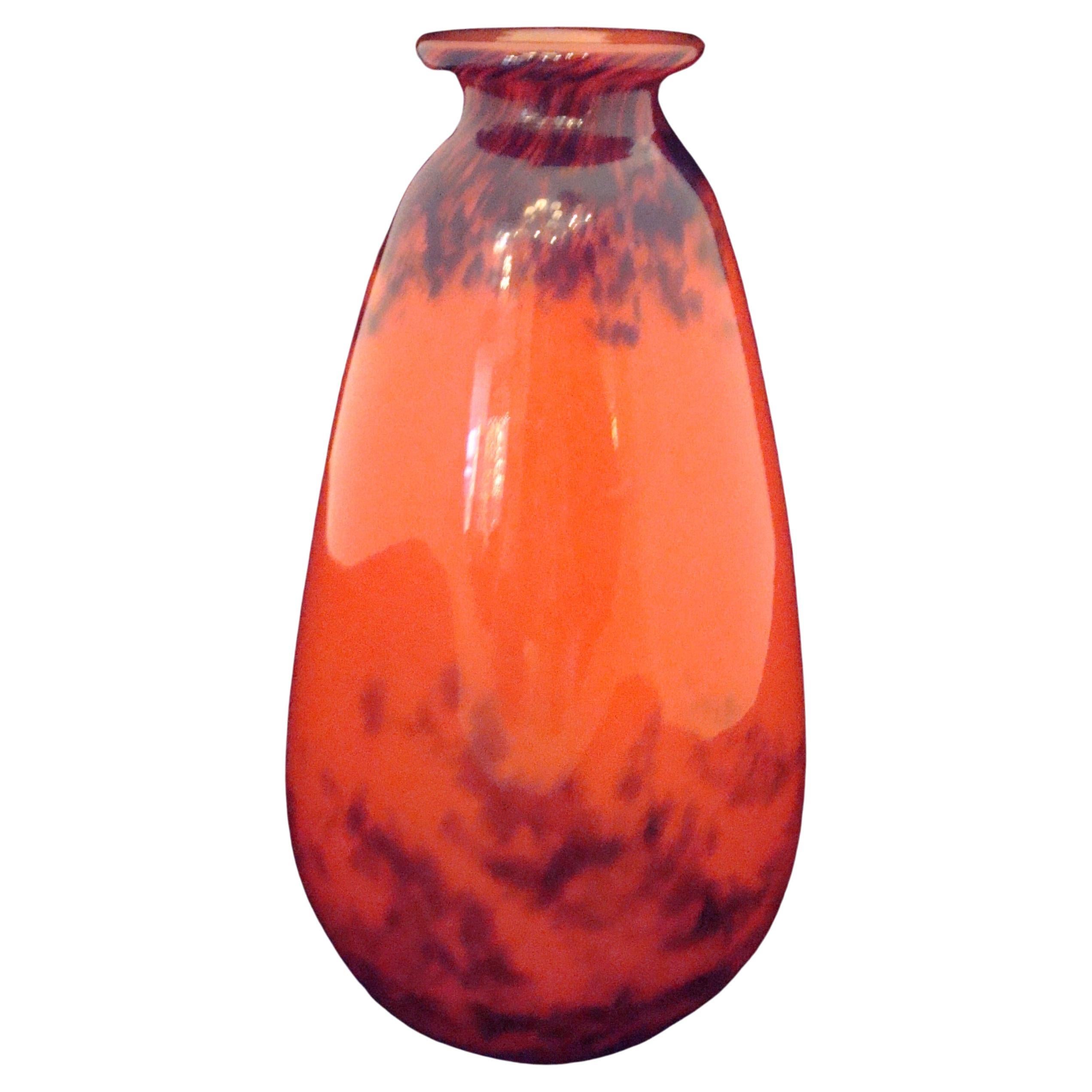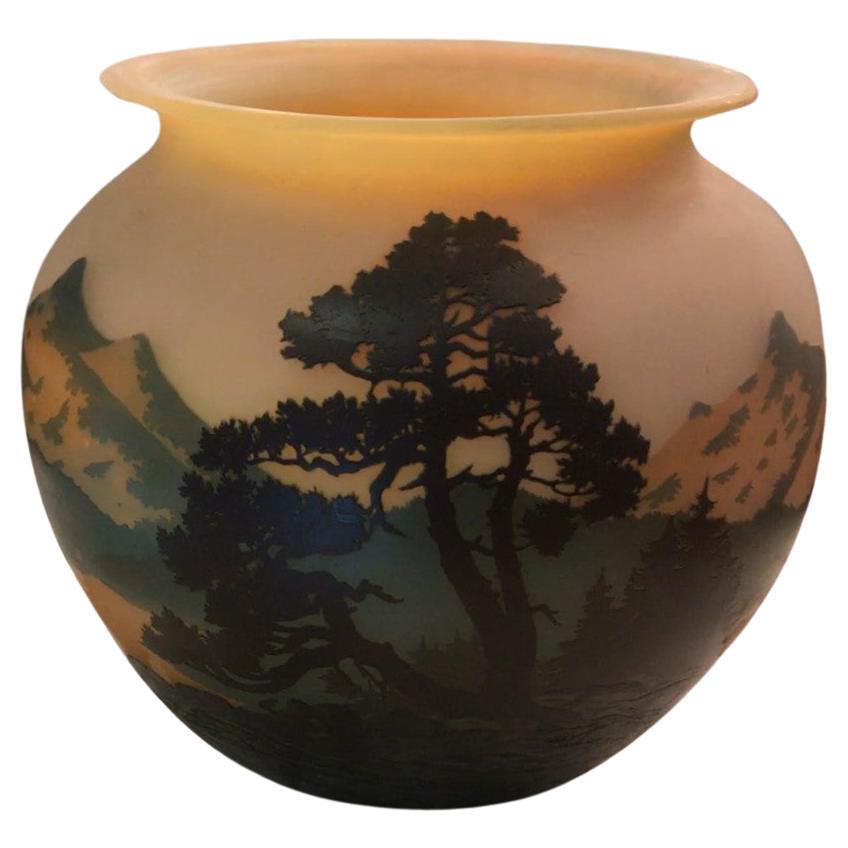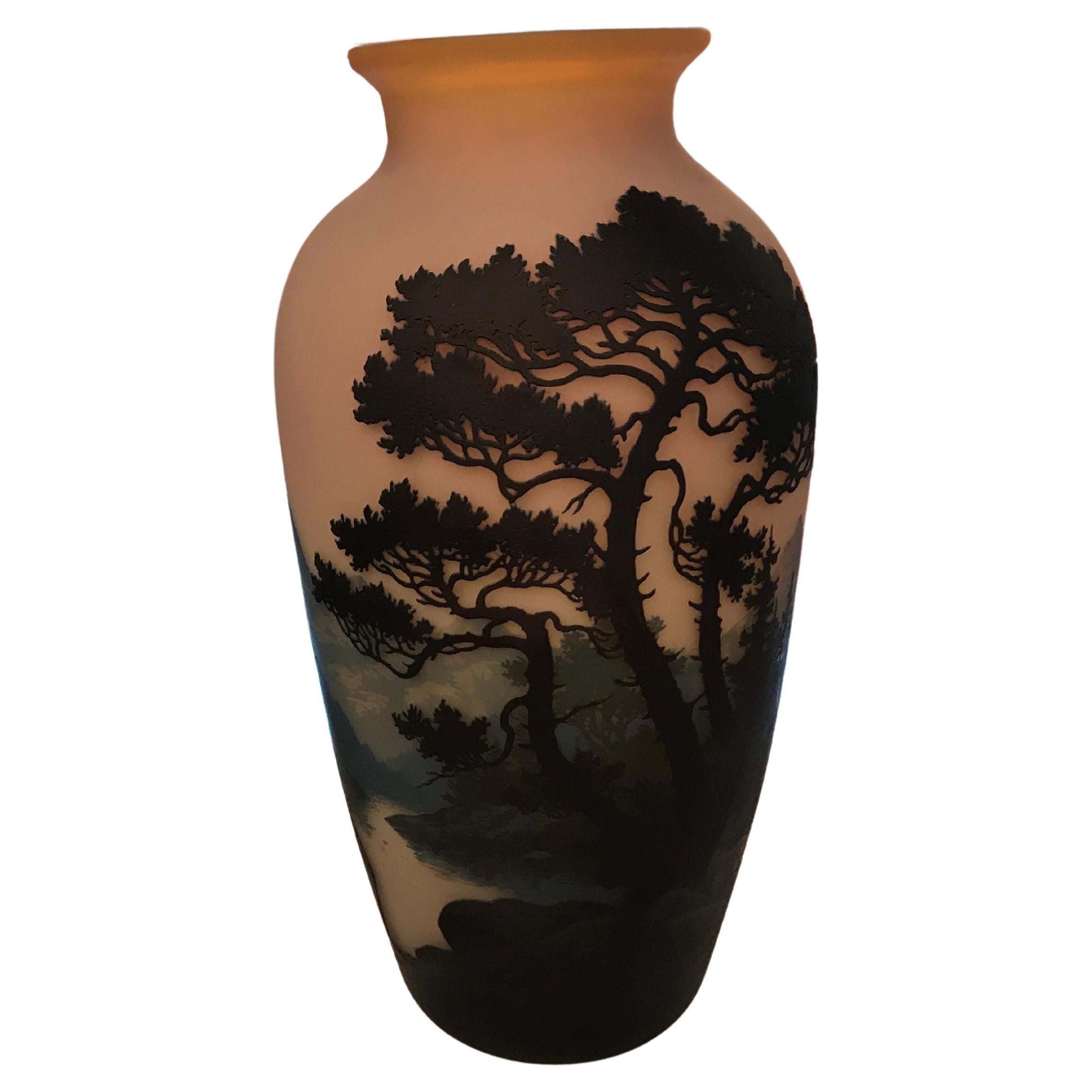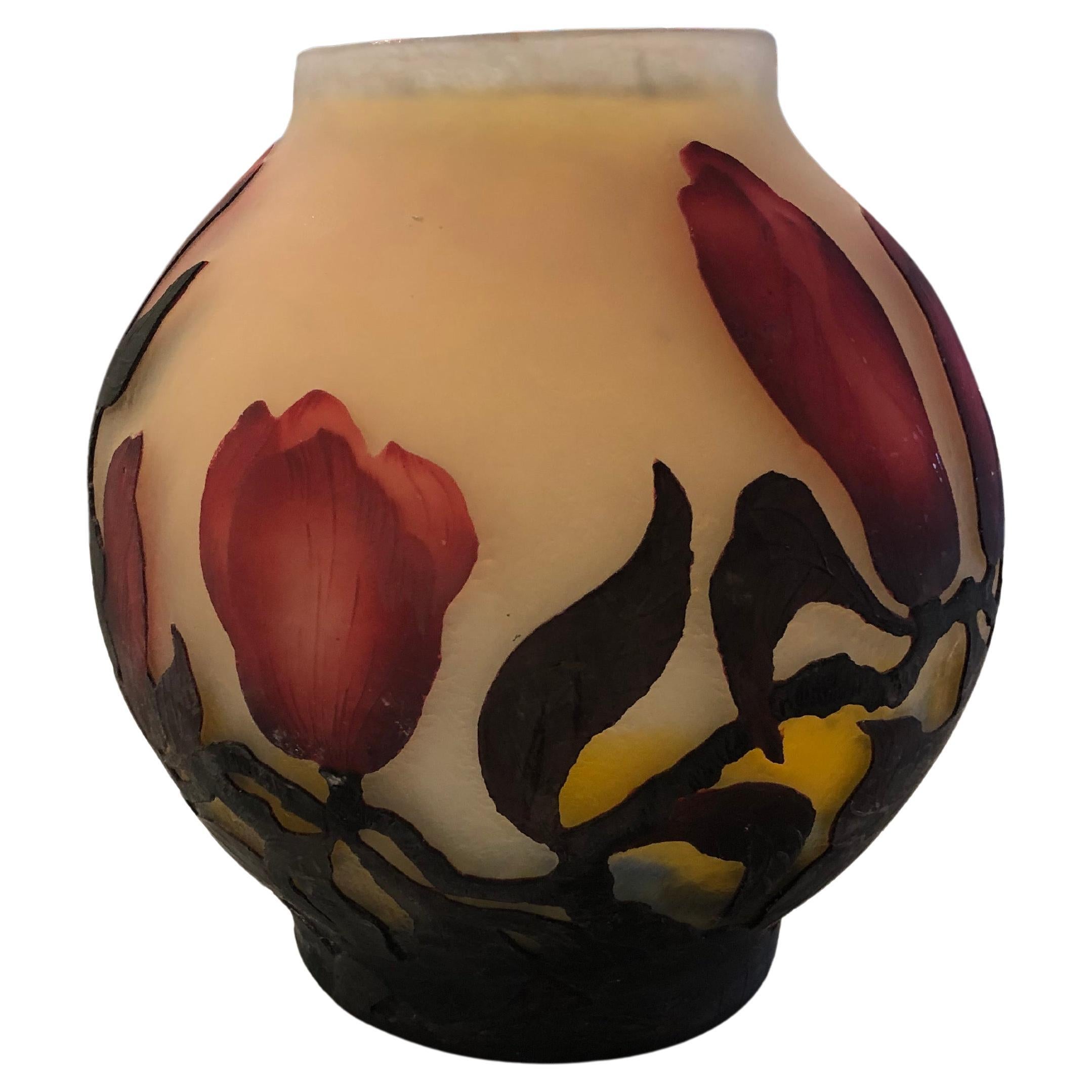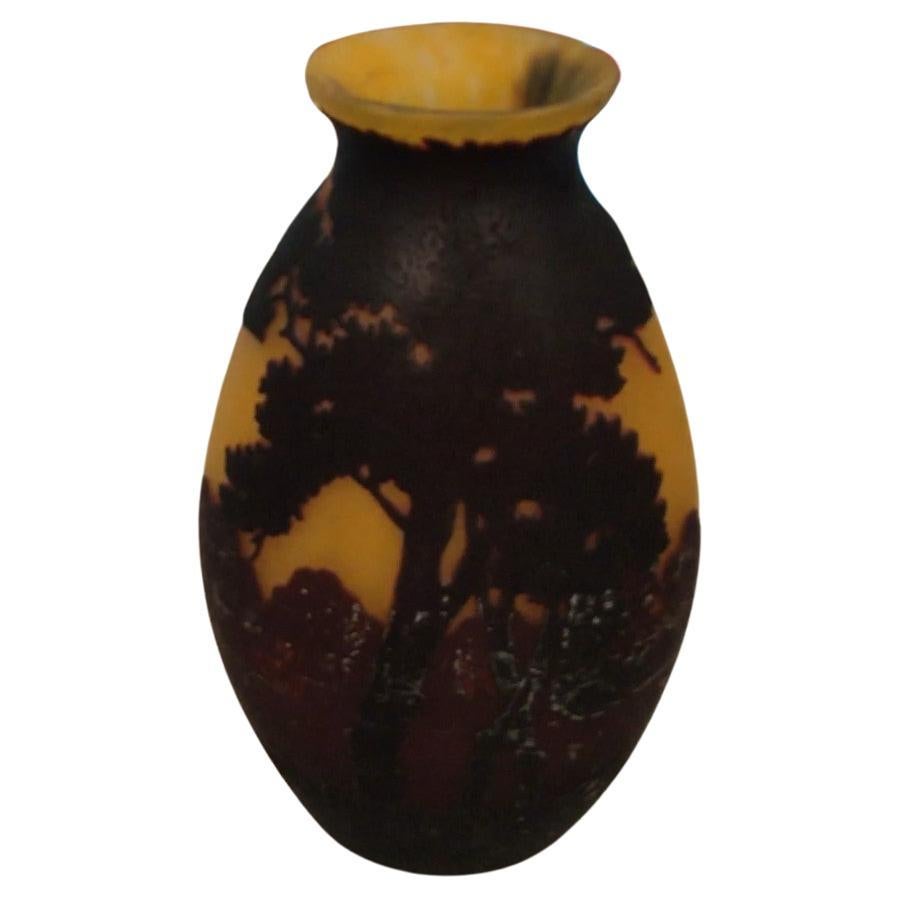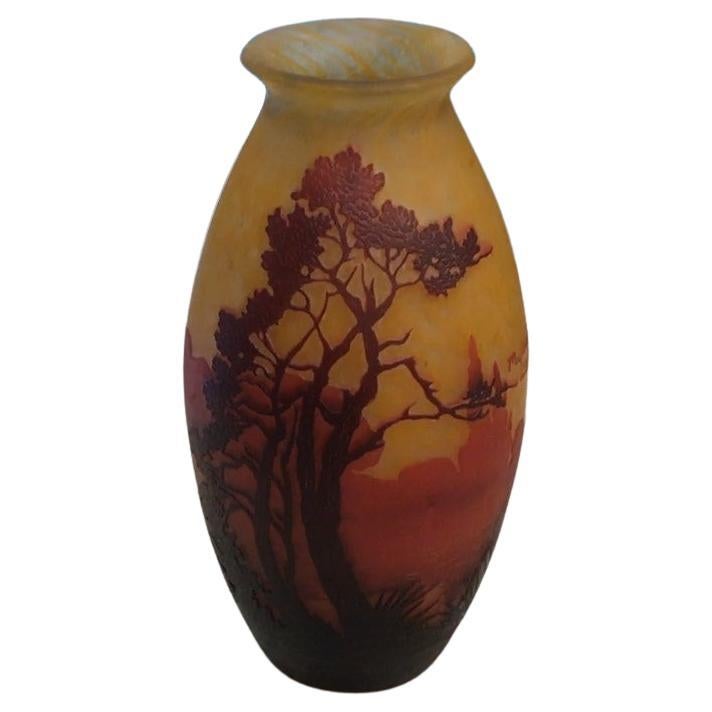Items Similar to Vase Sign: Muller Fres Luneville, Jugendstil, Art Nouveau, liberty
Want more images or videos?
Request additional images or videos from the seller
1 of 8
Vase Sign: Muller Fres Luneville, Jugendstil, Art Nouveau, liberty
About the Item
Vase Sign: Muller Fres Luneville
acid worked
Muller Feres
The heart of the company was formed by five brothers (Henri, Desire, Eugene, Pierre, Victor) from a glass making family who trained and worked at the Galle factory. Henri set up a decorating studio at Luneville in 1895 and was shortly joined by his brothers. Their production was predominantly cameo glass with blanks supplied by Gobeleterie Hinzelin, Croissmare. The studio sometimes used as many as six or seven different layers of colored glass, to craft their famous cameos, which were prized following similar lines to that of Galle and the Art Nouveau movement their production used nature as a decorative theme. It became the pre-eminent glass studio in France, outputting a great deal of original designs, created from a wide variety of new methods and materials. In the years leading up to the First World War their production was technically excellent and highly creative. Fluogravure stands where enamels applied to the body of the glass tubing is then heated. By the use of selective acid etching a wide range of effects could be achieved from vivid hues to subtle twilight shades. They designed cameo vases, using this production method, for Val St Lambert. They also worked with Chapelle, integrating metal and glass to create strangely kitsch flights of birds and snails amongst others. Production ceased at the start of the First World War during which Eugene was killed.
We have specialized in the sale of Art Deco and Art Nouveau and Vintage styles since 1982. If you have any questions we are at your disposal.
Pushing the button that reads 'View All From Seller'. And you can see more objects to the style for sale.
Why are there so many antiques in Argentina?
In the 1880 – 1940 there was a grate wave of immigration encouraged by the periods of war that were taking place.
1st World War took place between 1914 and 1918
2nd World War took place between 1939 and 1945
The immigrants options were New York or Buenos Aires. Tickets were cheap and in Buenos Aires they were welcomed with open arms, as it was a country where everything was still to be done.
Argentina was the country of new opportunities, labour was needed and religious freedom was assured, in many cases the of the family travel first until they were settled and then the rest of the family members join them.
In the immigrant museum “Ellis Island Immigrant Building” in New York you can se the promotional posters of the boats that would take them to a new life.
Between the years 1895 and 1896, Argentina had the highest DGP (gross domestic product) per capita in the world according to the Maddison Historical Statistics index, this situation arose due to the large amount of food being exported to European countries, which were at war.
The Argentinean ships left the port of Buenos Aires with food, but they returned with furniture, clothes and construction elements, (it´s common to see this the old buildings of the historic neighbourhood of San Telmo, the beams with the inscription “Made in England)”, as well as many markets that were built in Buenos Aires, such us the San Telmo Market, whose structure was brought by ship and afterwards assembled in 900 Defensa Street.
With the great influence of European immigrants living in the country, the children of the upper classes travelled to study in France, resulting in the inauguration of “La Maison Argentinienne”, on 27th of June 1928, in the international city of Paris, which hosted many Argentinians that were studying in Frace.
It´s the fourth house to be built after France, Canada and Belgium, being the first Spanish-speaking one. Still in place today (17 Bd Jourdan, 75014, Paris, France). Many of the children of these wealthy families who attended international art exhibitions, museums and art courses abroad, took a keen interest in the European style. This is why Buenos Aires was at the time referred as “The Paris of South America”.
Between the years 1890 and 1920 more than a hundred Palaces were built on Alvear Avenue the most exclusive avenue in Buenos Aires. Today some of these palaces have been transformed into museums, hotels and embassies.
In the year 1936, the Kavanagh building was inaugurated, it was the tallest reinforced concrete building in South America.
During 1994 the American Society of Civil Engineers distinguished it as an “international engineering milestone”, and it´s now considered a World Heritage of Modern Architecture.
At the time was common to hire foreign architects such as Le Corbusier, who visited Buenos Aires/Argentina in 1929 and in 1948 he drew up the blueprints for a house built in La Plata City (which was declared a World Heritage Site).
In 1947, the Hungarian architect Marcelo Breuer designed “Parador Ariston” in the seaside city of Mar del Plata. After an Argentinean student at Harvard University convinced him to come to Argentina. He worked on an urban development project in the Casa Amarilla, area of La Boca.
The Ukrainian architect, Vladimiro Acosta, arrives in Argentina in 1928 and worked as an architect until que moved to Brazil.
Antonio Bonet, a Spanish architect who worked with Le Corbusier in Paris, arrives in Argentina in 1937, where he carried out several architectural works and in 1938 designs the well-known BFK chair.
Andres Kálnay, of Hungarian origin, made around 120 architectural masterpieces, among which the former Munich brewery stands out, he even made the furniture’s design.
The German architect, Walter Gropius, director of the Bauhaus, lived in Argentina, where he wrote articles for “Sur” magazine and founded in Buenos Aires, an architectural firm with Franz Möller, who was also an architect, where he built two houses.
At the same time several famous designers decided to immigrate to Argentina, among them we can find the well-known French designer, Jean-Michel Frank, who arrived in the country in 1940 and also worked for the Rockefeller family.
Special pieces were made, which were sold exclusively in the country, such as the well-known German company “WMF”, who sold their products by catalogue, which were chosen by the ladies of high society in the list of wedding gifts, as well as the pieces designed by Christofle.
The Swiss sculptor Alberto Giacometti, made special pieces for Argentinean mansions.
In 1904 the first Jansen branch outside Paris was established in Buenos Aires, as the Argentinean clientele demanded a large amount of furniture, from the end of the 19th century to the mid-20th century.
In 1970, the brand Rigolleau Argentina made pieces authorised by Lalique.
The brands Maple and Thompson also set up shop in the country.
The French plastic artist, Marcel Duchamp moved to Argentina in 1918-1919.
Glass signed Gallé, Charder, Leverre, Schneider, Muller and other French firms. They were bought in flower shops and were given to ladies with beautiful floral arrangements.
Some furniture manufacturers travelled to international fairs and bough the patterns to produce the furniture in Argentina, such as the furniture firm Englander and Bonta, who bought the patterns ins Italy.
It is worth mentioning that in Argentina we have the largest community of Italians outside of Italy, as it is estimated that 70 percent of the inhabitants have at least one Italian descendant, followed by Spanish immigrants.
The most Important furniture stores in Argentina:
Comte is founded in 1934 (under the direct management of Jean Michel Frank in 1940).
Nordiska (Swedish company established in 1934).
Churba in 1960, a company that brought foreign designers to present their furniture in the country:
Denmark: (Arne Jacobsen, Finn Juhl, Bender Madsen, Ejner Larsen, Poul Kjaerholm, Hans Wegner)
Sweden: (Hans Agne Jakobsson, Gustavsberg)
United States: (Herman Miller)
Finland: (Lisa Johansson, Folke Arstrom, Tapio Wirkkala, Alvar Aalto, Timo Sarpaneva)
Swedish Factory: (Orrefors)
Italy: (Littala, Vico Magistretti, Emma Gismondi, Gae Aulenti, Angelo Mangiarotti, Elio Martinelli, Gianna Celada, Angelo Mangiarotti, Mario Bellini, Carlo Scarpa)
Finland: (Olivia Toikka)
Plata Lappas (Lappas Silver): a goldsmith shop founded in 1887 in Argentina by Alcibiades Lappas of Greek origin.
In 2019, in Argentina took place “the Art Deco world congress”, in which we participated as hosts invited by Geo Darder, founder of the Copperbridge – Foundation, in which prominent people from all over the world attended to learn about Art Deco in Argentina.
Argentina currently has more than 100 Art Deco buildings and another 90 Art Nouveau buildings throughout the city of Buenos Aires.
Argentina is a country that has not been involved in many wars, which is why it has been a refuge for works of art and antiques from different periods of time, unlike European countries. That is way many collectors, museums and antique dealers from all over the world visit it, you should not miss the opportunity to visit this great country.
Laura Guevara Kjuder, architect.
- Creator:Muller Frères (Designer)
- Dimensions:Height: 9.45 in (24 cm)Diameter: 5.52 in (14 cm)
- Style:Art Nouveau (Of the Period)
- Materials and Techniques:
- Place of Origin:
- Period:1900-1909
- Date of Manufacture:1900
- Condition:Wear consistent with age and use.
- Seller Location:Ciudad Autónoma Buenos Aires, AR
- Reference Number:
About the Seller
5.0
Vetted Seller
These experienced sellers undergo a comprehensive evaluation by our team of in-house experts.
Established in 1982
1stDibs seller since 2022
21 sales on 1stDibs
Typical response time: <1 hour
- ShippingRetrieving quote...Ships From: Ciudad Autónoma Buenos Aires, Argentina
- Return PolicyThis item cannot be returned.
More From This SellerView All
- Vase Sign: Muller Fres Luneville, Jugendstil, Art Nouveau, libertyBy Muller FrèresLocated in Ciudad Autónoma Buenos Aires, CVase Sign: Muller Fres Luneville acid worked Muller Feres The heart of the company was formed by five brothers (Henri, Desire, Eugene, Pierre, Victor) from a glass making family who ...Category
Antique Early 1900s French Art Nouveau Glass
MaterialsArt Glass
- Vase, Sign: Muller Fres Luneville, Style: Jugendstil, Art Nouveau, libertyBy Muller FrèresLocated in Ciudad Autónoma Buenos Aires, CVase Sign: Muller Fres Luneville acid worked Muller Feres The heart of the company was formed by five brothers (Henri, Desire, Eugene, Pierre, Victor) from a glass making family who ...Category
Antique Early 1900s French Art Nouveau Glass
MaterialsArt Glass
- Monumental Vase, Sign: Muller Fres Luneville, Jugendstil, Art Nouveau, libertyBy Muller FrèresLocated in Ciudad Autónoma Buenos Aires, CVase Sign: Muller Fres Luneville acid worked Muller Feres The heart of the company was formed by five brothers (Henri, Desire, Eugene, Pierre, Victor) from a glass making family who ...Category
Antique Early 1900s French Art Nouveau Glass
MaterialsArt Glass
- Vase, Sign: Muller Fres Luneville, Style: Jugendstil, Art Nouveau, LibertyBy Muller FrèresLocated in Ciudad Autónoma Buenos Aires, CVase Sign: Muller Fres Luneville acid worked Muller Feres The heart of the company was formed by five brothers (Henri, Desire, Eugene, Pierre, Victor) from a glass making family who ...Category
Antique Early 1900s French Art Nouveau Glass
MaterialsArt Glass
- Vase, Sign: Muller Fres Luneville, Style: Jugendstil, Art Nouveau, LibertyBy Muller FrèresLocated in Ciudad Autónoma Buenos Aires, CVase Sign: Muller Fres Luneville acid worked Muller Feres The heart of the company was formed by five brothers (Henri, Desire, Eugene, Pierre, Victor) from a glass making family who ...Category
Antique Early 1900s French Art Nouveau Glass
MaterialsArt Glass
- Vase, Sign: Muller Fres Luneville, Style: Jugendstil, Art Nouveau, LibertyBy Muller FrèresLocated in Ciudad Autónoma Buenos Aires, CVase Sign: Muller Fres Luneville acid worked Muller Feres The heart of the company was formed by five brothers (Henri, Desire, Eugene, Pierre, Victor) from a glass making family who ...Category
Antique Early 1900s French Art Nouveau Glass
MaterialsArt Glass
You May Also Like
- Large Blue Muller Freres Luneville French Art Deco Intercalaire Art Glass VaseBy Muller FrèresLocated in Philadelphia, PAA large Muller Freres Luneville Art Deco Intercalaire art glass vase. A fantanstic period vase in the difficult 'intercalaire' technique (in which the decoration is inserted between two layers of glass). With silver inclusions and red, yellow and black deco form glass internal layers. Simply top level Art Deco glass from one of France's best glass houses! Marks: Base bears an etched signature: Muller Fres Luneville France...Category
Early 20th Century French Art Deco Vases
MaterialsBlown Glass
- Loetz Art Nouveau Jugendstil Art Glass BowlBy Loetz GlassLocated in Miami, FLA stunning Loetz art glass green bowl decorated with gold inclusions. The glass manufacturer Loetz after their big success at the Paris World Exhibition in 1900. While creating decoration variants, the owner of the glass workshop, Max Ritter von Spaun, was presumably inspired by works of Louis C. Tiffany. The applied applications by Loetz are positioned more prominently and have their own ornament in the form of pulled iridescent threads. This glass work of art known as Loetz Jugendstil...Category
Early 20th Century Austrian Art Nouveau Vases
MaterialsGlass, Art Glass
- Soliflore glass vase signed Gallé, Art Nouveau, FranceBy Emile GalléLocated in Paris, FRSmall soliflore vase in glass paste Signed Gallé, France Art Nouveau, early 20th century.Category
Early 20th Century French Art Nouveau Vases
MaterialsGlass
- Muller Freres Luneville French Art Deco Glass VaseBy Muller FrèresLocated in Hamilton, OntarioMuller Freres Luneville French Art Deco glass vase.Category
Early 20th Century French Art Deco Vases
MaterialsArt Glass
- Art Nouveau Style Art Glass Vase Signed Contemporary, circa 1980sBy Robert EickholtLocated in New York, NYA very beautiful contemporary art glass vase in the Art Nouveau style, by artist Robert Eickholt, circa 1980s. Vase is signed "Eickholt" and dated "1988" on bottom as shown in last t...Category
Late 20th Century American Art Nouveau Glass
MaterialsArt Glass, Blown Glass
- Glass Vase Signed Gallé, Art Nouveau, France 20th centuryBy Emile GalléLocated in Paris, FRVase in glass paste, green color, decor of ferns and flowers. Multi-layered, acid-cleared glass. Signed Gallé, France. Art Nouveau, early 20th century.Category
20th Century French Art Nouveau Vases
MaterialsGlass
Recently Viewed
View AllMore Ways To Browse
Enamel Button Set
Schneider Cameo
1900 Century Italian Vases
Heart Sarpaneva
Pre Civil War Chair
Art Nouveau Glass Metal
Carlo Scarpa Etching
Concrete Snail
Laura Lambert
French Metal Train Case
French Deal Paris
Walter Lambert
Fres Paris
Heart Set Hans Wegner
Lalique Snail
Jugendstil Glass Metal
Hans Wegner Heart Set
Swedish 1960 Fining Chairs
